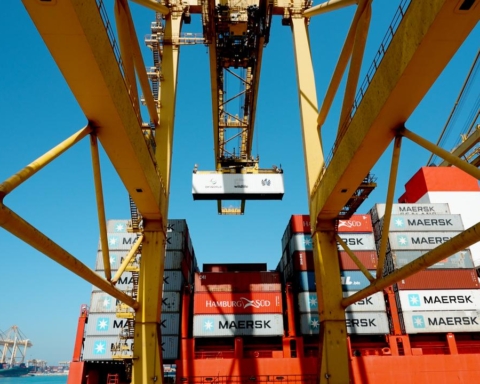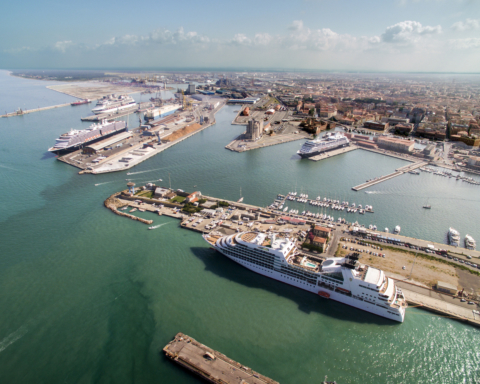The automotive market is sailing at full speed, with very encouraging medium to long term development forecasts. This is supported by the latest study by SRM (Studi Ricerche Mezzogiorno) entitled: “The trends and prospects of the automotive sector in the international context”, according to which the vehicle shipping trade will grow by 2022 at a rate of 2.5% per year. The driving force will be the recovery of Asian volumes towards Europe (+2.7% annual average) and the growth of intra-Asian trade (+4.2% annual average, equal to +1.9 million Car Equivalent Units).
The report, prepared in collaboration with the North Tyrrhenian Port Network Authority’s Studies, Planning and Logistics Department presented a few days ago in Livorno by Salvio Capasso (Head of the Business and Local Economy Office ) and Olimpia Ferrara (Coordinator of the Maritime Observatory), shows that in 2017 the transport of vehicles by sea has grown by 3.7%, at a higher rate than the growth in global sales of new cars, which was 3.1%.
Globally, in 2017 the shipping mode reached 24.3%: 23.5 million vehicles (+3.7%) travelled by ship out of a total of 96.8 million sold worldwide. This figure takes account of “domestic” sales in the countries where cars are manufactured: “If only exported vehicles are taken into account, the equivalent of 31.2 million units, the share of sea transport is equal to 75%”.
For SRM, sea transportation for this type of product is still one of the cheapest: its impact on manufacturing costs is in fact very low (on average between 1 and 3% of the price of the car).
Market flows
On the basis of an in-depth analysis of the global picture of vehicle transportation by sea , SRM points out that the growth of emerging markets has led to greater fragmentation of routes, with volumes drained from the busiest to new routes with shorter distances. For the study centre connected to the Intesa San Paolo Group, this evolution is also explained by the need, on the part of carriers, to optimize their network and reduce the impact of commercial imbalances.
Considering the various flows of the shipping trade, SRM highlights how the East-West routes – which, ten years ago, concentrated half the world trade volumes – have gradually lost significant shares in traffic: in 2017 15.6 million vehicles were handled,1.5 million less than in 2007.
In 2017, the North-South trade (Latin America, Sub-Saharan Africa, Oceania), on the other hand, concentrated 8 million vehicles, representing 21.5% of the global shipping trade, while 12.9 million vehicles (34.4% of total trade) were handled along regional routes (Intra-NAFTA /USMCA, Intra-Med, Intra-Asia, Intra-Latin America excluding Mexico).
The connections between Asia, Europe and the Mediterranean are, after the transpacific ones, the busiest for the long-range vehicle transportation. Westbound traffic closed 2017 with a +5.4% (3.8 million ECUs), although over ten years its share of global trade has almost halved, going from 20% in 2007 to 10% last year.
A number of factors have contributed to the reduction of traffic flows along this route: SRM cites as examples the war in Syria, lower sales in North Africa in the wake of the Arab Spring, the increase in domestic production in Morocco and the drastic drop in exports from South Korea and Japan to Russia.
In the eastbound direction, traffic has recorded an average annual growth of 6.1% over the last decade. This trend is largely due to the increase in Chinese imports of German luxury cars.
Turning to transpacific connections, analysts have found that Asian exports to North America have continued to grow thanks to the strong US automobile market, reaching 4.8 million CEUs in 2017. Westbound trade, on the other hand, remains marginal and accounts for less than 2% of global volumes.
And then there is transatlantic trade: in 2017 vehicle sales in the USA pushed volumes westwards (from Europe to the American continent) to a new high, reaching 2.3 million CEUs. SRM forecasts that this traffic will decrease at an average annual rate of 0.8% until 2022, as a result of an increase in North American production capacity and a slowdown in demand.
In the Eastbound direction, North American transatlantic exports grew by 4% in 2017, reaching 0.9 million CEUs. Volumes are expected to grow by 2% in 2018, with an average annual slowdown of 1.5% until 2022.
Finally, SRM experts also devote considerable space to traffic on regional Intra-Med routes, which fell by 3% for the second consecutive year to 1.3 million ECUs in 2017. “However – the study says – from 2013 Morocco has partly compensated for the gap, increasing production to supply the EU market and gaining, in 2017, a share of 33% of vehicle trade in the Mediterranean.”
European ports
In its study, SRM also points out that European ports certainly remain among the most important in terms of vehicle handling, although there are fewer and fewer ports in the top 20 worldwide (if, in 2007, there were 13, today there are 9).
The first ten European ports together handle something like 12.8 million vehicles. Zeebrugge (2.8 million vehicles in 2017) and Bremerhaven (2.2 million TEU) remain in first place, while Livorno, Italy’s leading port of call in this business segment, ranks 10th.
With regards to Livorno: on the basis of the analysis of the main routes of Central and Northern Italy that can use the port of Livorno as their hub (like, for instance, Spain, Portugal, Sweden, the Balkans and Turkey, the Far East, North Africa, the United States and the Middle East), SRM estimated that, in the first half of 2018, the market value managed by the port was “estimated at about 4.5 billion euros of commercial interchange (9.2 billion for the entire year).”
Analysts are convinced of this: Livorno, which in 2018 handled 666,000 new cars (534,597 disembarking and 131,737 embarking), can serve as a primary hub for the automotive market basin of Central Italy, with significant auxiliary functions also for the North of the country. For this reason, growth estimates for 2022 could lead to an increase in market volumes of around 13%.
According to SRM, the growing demand of the market will put pressure on specialized ports of call, which will be used more and more frequently as storage areas: the growth of the automotive market will create unprecedented problems of traffic management. For European ports, and especially for Italian ports, the availability of space in terms of quays and yards will become a matter of life and death.
Translation by Giles Foster




